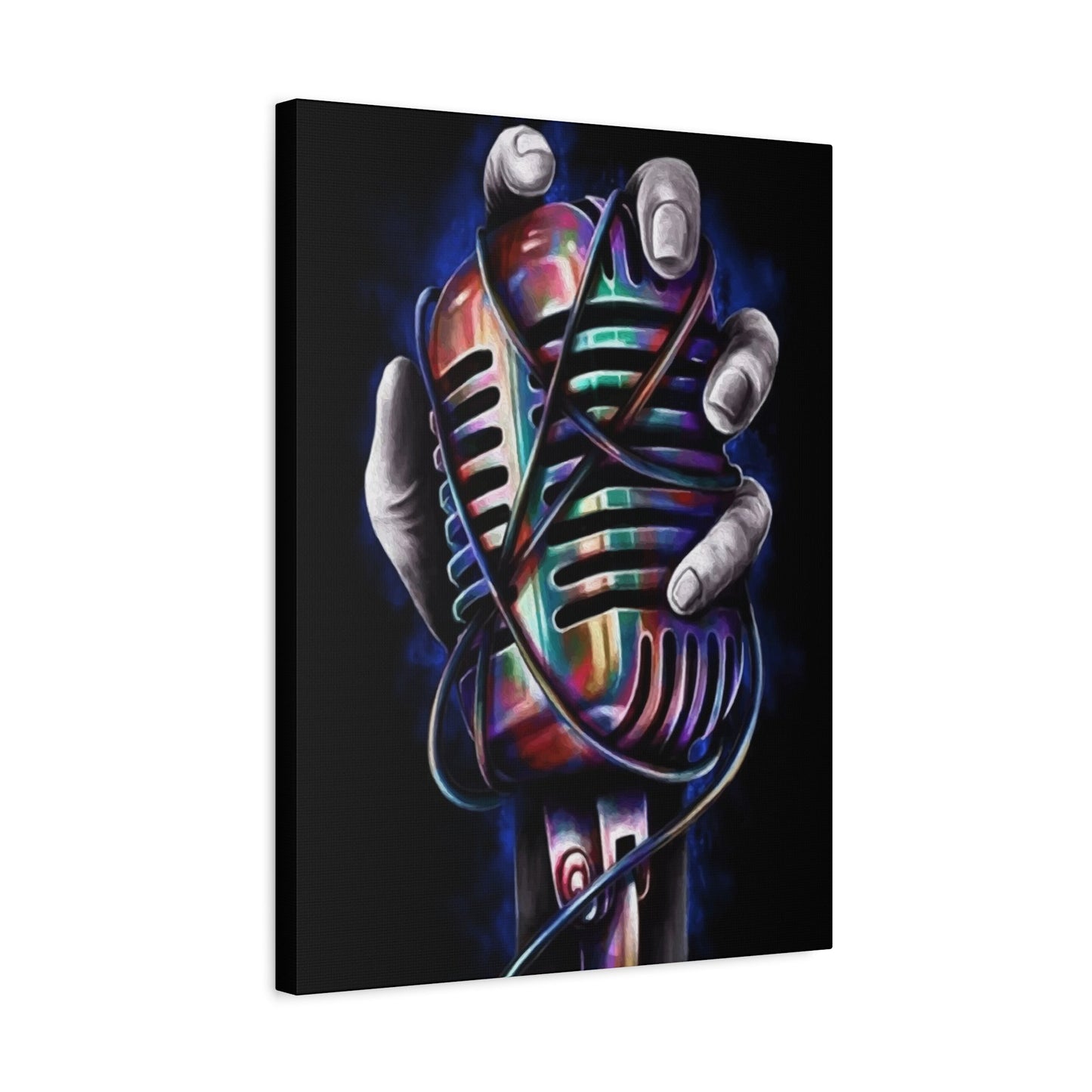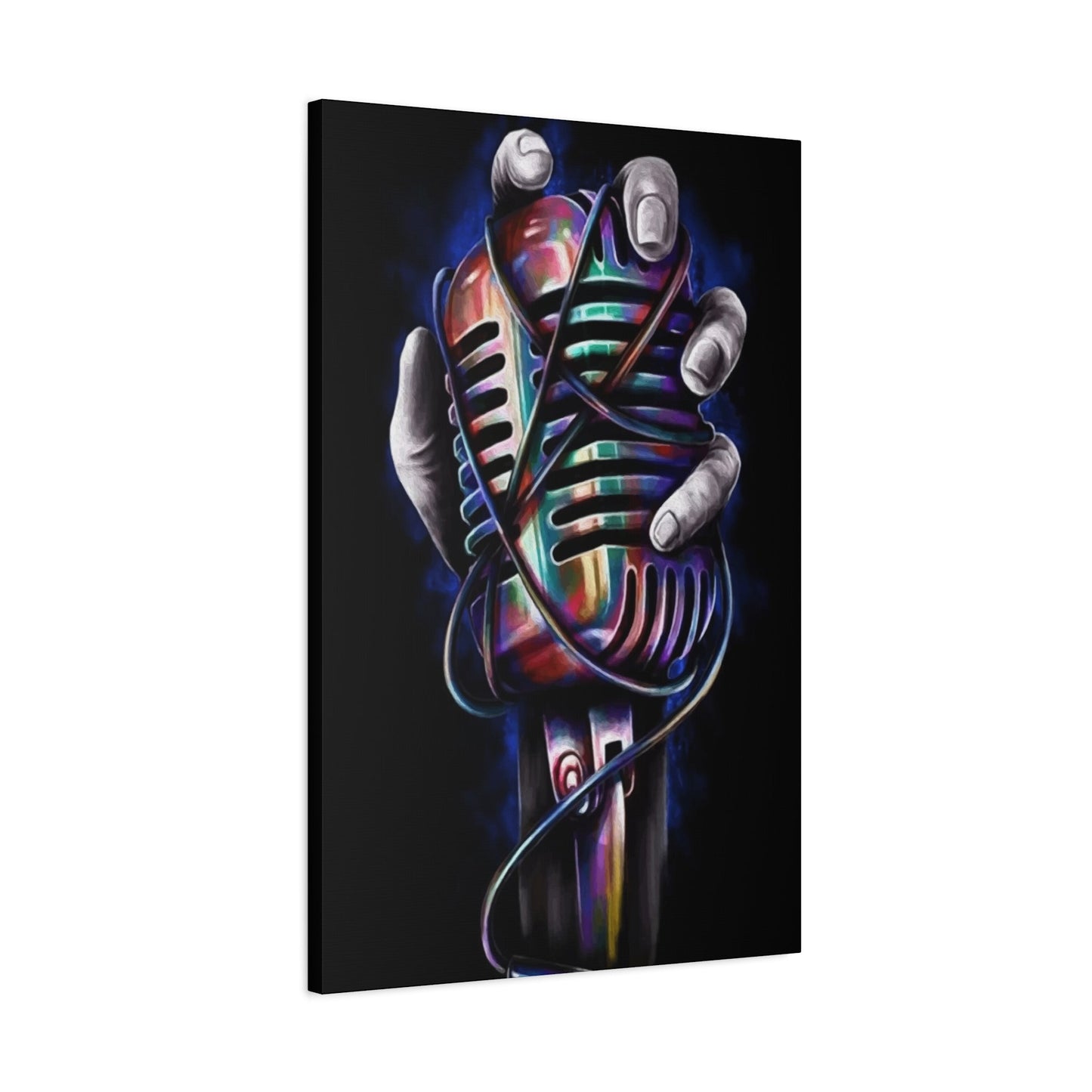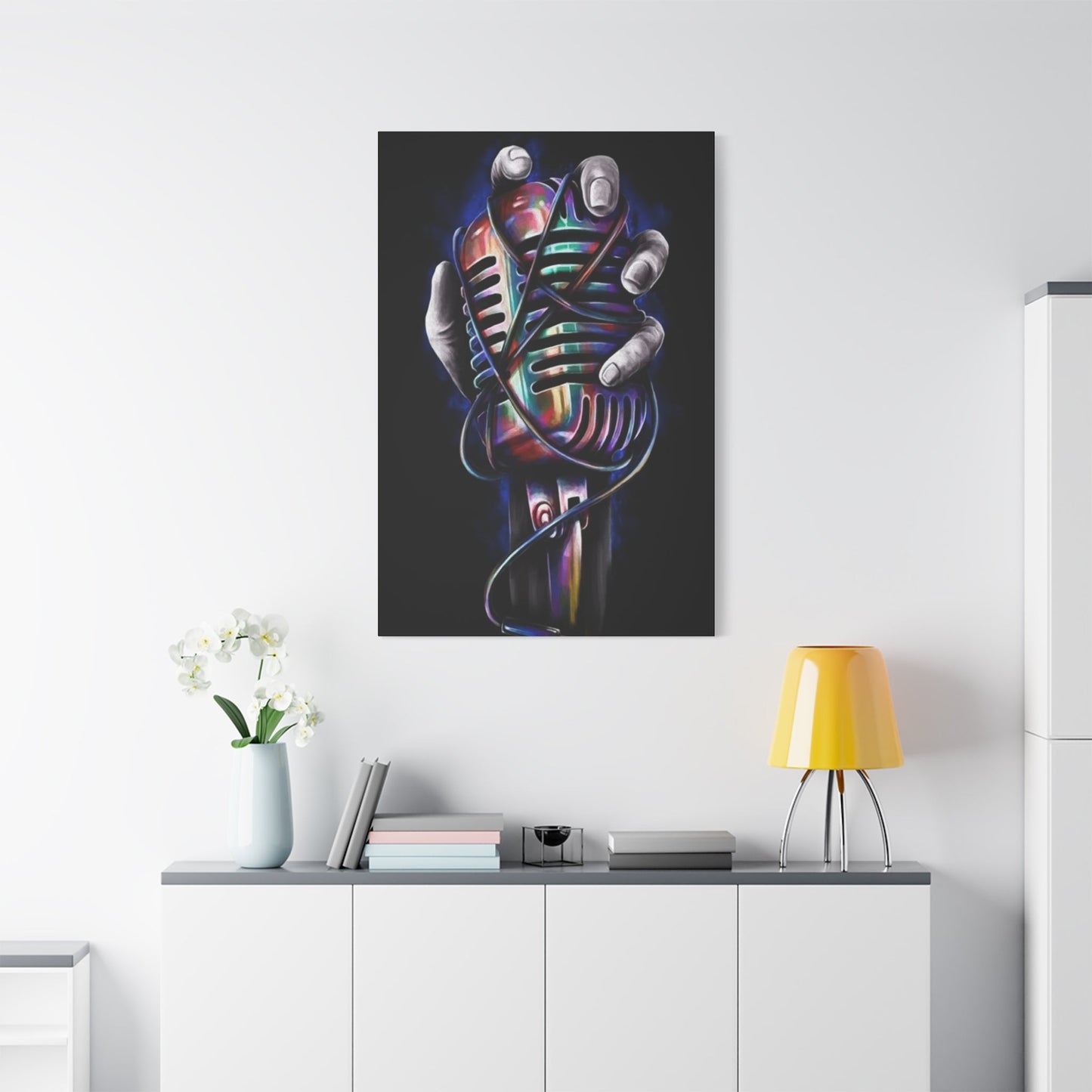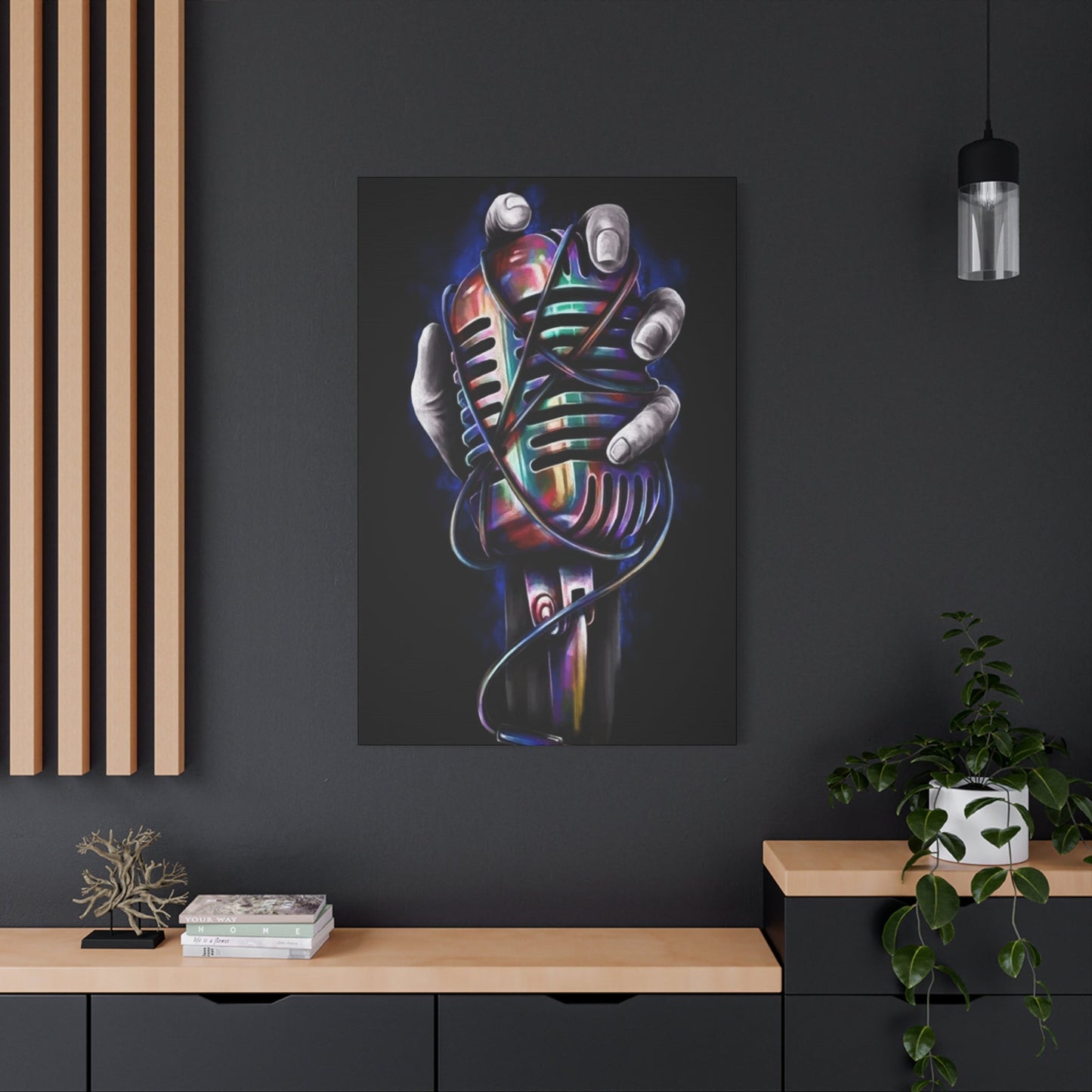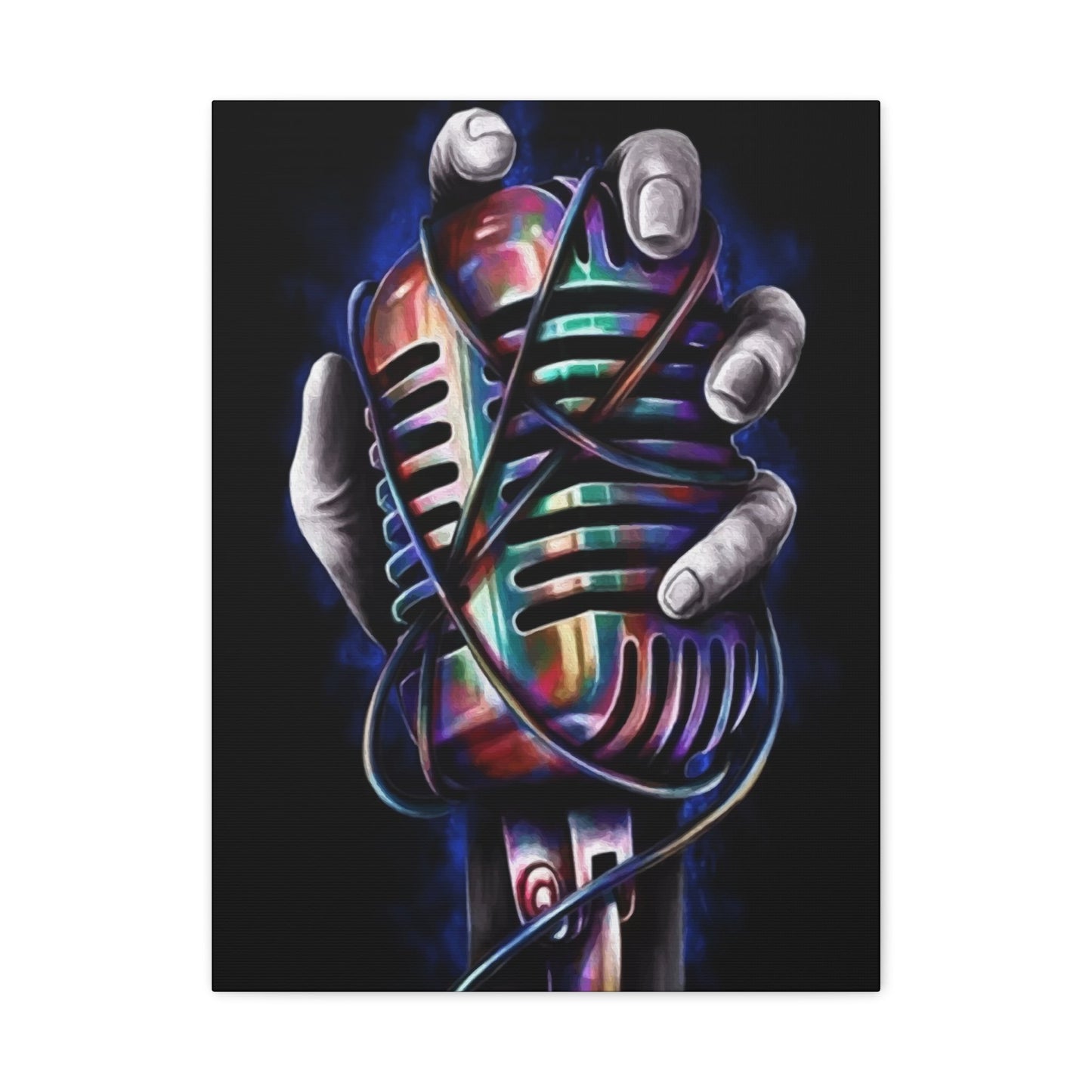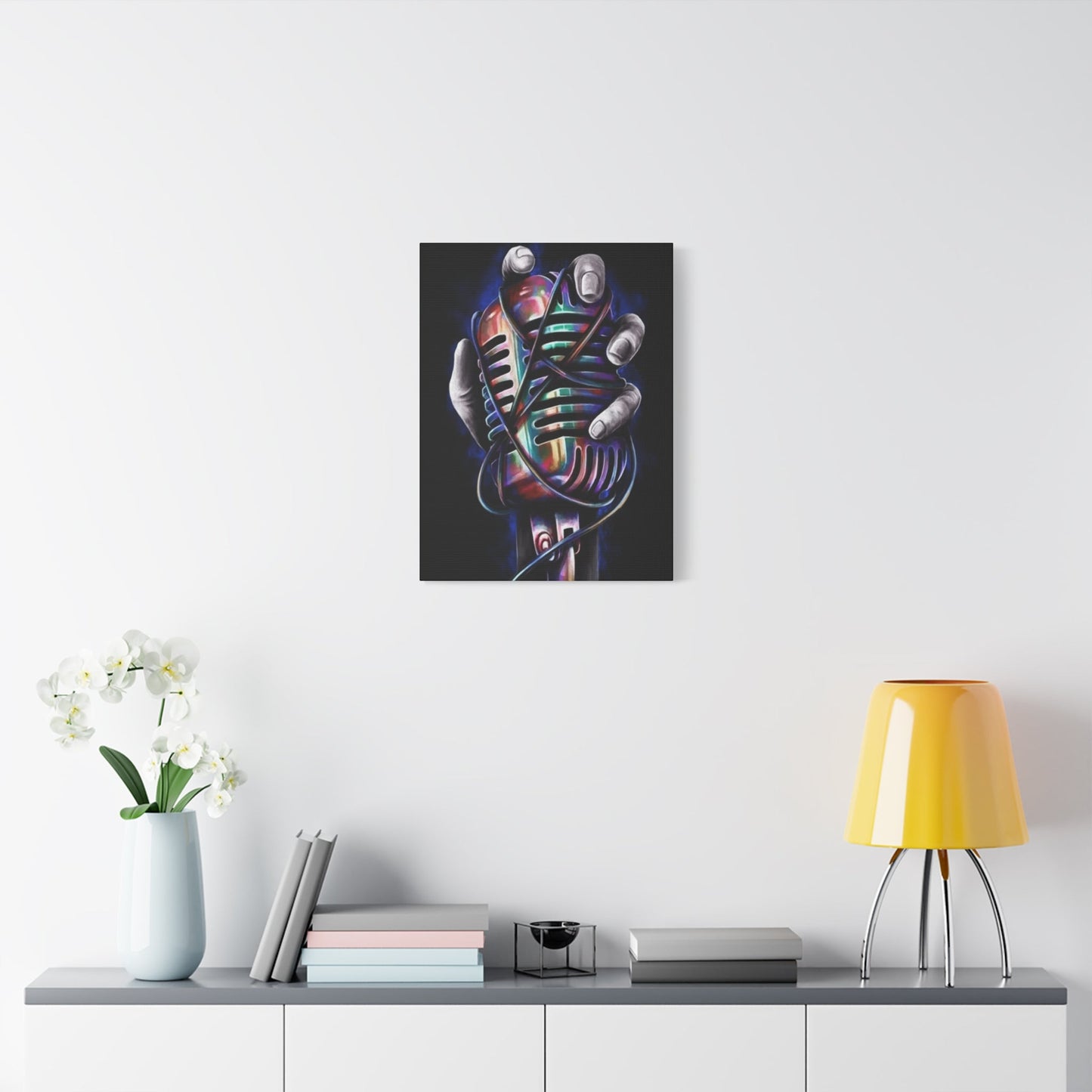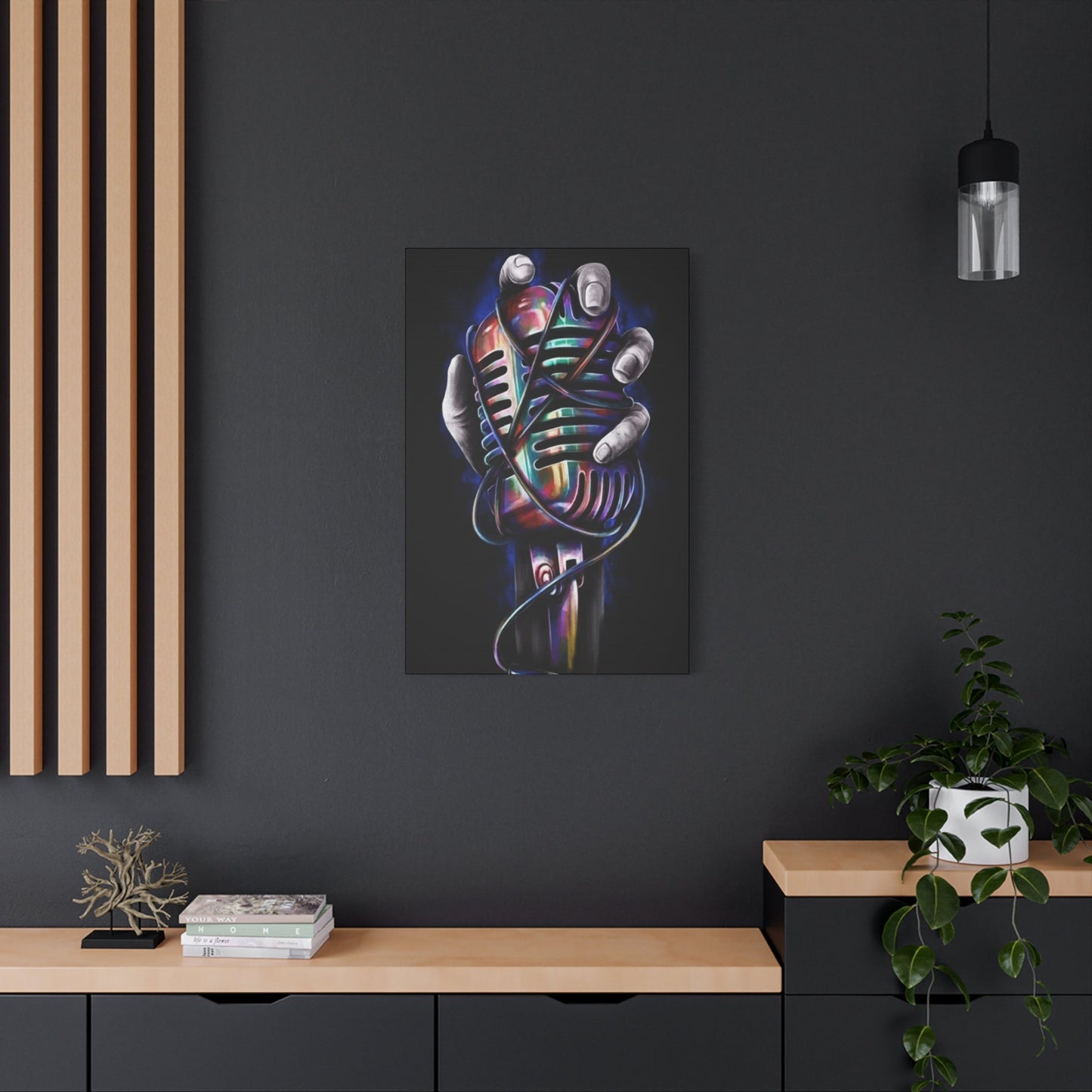Mic Wall Art: Amplify Your Space with Musical Vibes
The world of interior design has witnessed a remarkable surge in music-themed decorative pieces, with mic wall art emerging as a captivating focal point for countless spaces. These artistic representations of microphones transcend mere decoration, embodying the soul of musical expression and creative passion. Whether adorning the walls of professional recording studios, home music rooms, or contemporary living spaces, microphone wall art serves as a powerful testament to the universal language of music.
The allure of mic wall art lies in its ability to instantly communicate creativity, passion, and artistic dedication. Unlike generic decorative pieces, these specialized artworks carry profound meaning for music enthusiasts, performers, and anyone who appreciates the power of sound. From vintage-inspired designs that pay homage to classic recording equipment to modern interpretations that celebrate contemporary musical styles, mic wall art offers endless possibilities for personal expression.
Contemporary homeowners and designers increasingly recognize the transformative power of music-themed decor. Microphone wall art pieces serve as conversation starters, mood enhancers, and visual representations of personal interests. They bridge the gap between functional space and artistic expression, creating environments that reflect the inhabitant's passion for music and sound.
The versatility of mic wall art extends far beyond traditional music rooms. These captivating pieces find their place in bedrooms, living rooms, home offices, and even commercial spaces like cafes, restaurants, and retail establishments. Their universal appeal stems from music's ability to transcend cultural, generational, and social boundaries, making microphone-themed artwork relevant to diverse audiences.
Exploring Diverse Styles and Artistic Interpretations
Mic wall art encompasses an extraordinary range of artistic styles, materials, and interpretations. From hyperrealistic metal sculptures that replicate vintage ribbon microphones to abstract paintings that capture the essence of sound waves, artists continue to push creative boundaries in this specialized niche. The diversity of available options ensures that every music lover can find pieces that resonate with their personal aesthetic preferences and complement their existing decor.
Vintage-style microphone art often features classic designs reminiscent of broadcasting's golden age. These pieces typically showcase the iconic shapes of dynamic microphones, ribbon mics, and early condenser models that defined recording history. Artists frequently employ aged metal finishes, weathered textures, and muted color palettes to evoke nostalgia and pay tribute to music's rich heritage.
Contemporary mic wall art takes bold departures from traditional representations, incorporating modern materials, vibrant colors, and innovative design concepts. Digital art prints, LED-illuminated pieces, and mixed-media creations offer fresh perspectives on the classic microphone form. These modern interpretations often blur the lines between functional art and decorative sculpture, creating dynamic visual experiences that engage viewers on multiple levels.
Abstract interpretations of microphone imagery challenge conventional perceptions while maintaining recognizable elements. Artists might deconstruct the familiar microphone silhouette, reimagining it through geometric patterns, flowing lines, or surreal compositions. These pieces appeal to viewers who appreciate artistic innovation while celebrating musical themes.
Three-dimensional mic wall art adds depth and texture to flat wall surfaces. Sculptural pieces crafted from metal, wood, resin, or composite materials create striking shadows and visual interest. These dimensional artworks often serve as statement pieces, commanding attention and anchoring entire room designs around their presence.
Materials and Craftsmanship in Microphone Wall Art
The creation of exceptional mic wall art requires careful consideration of materials, each offering unique characteristics that influence the final piece's appearance, durability, and overall impact. Understanding these material properties helps collectors and decorators make informed decisions when selecting artwork for their spaces.
Metal remains the most popular material for creating realistic microphone wall art. Steel, aluminum, and copper offer excellent durability while allowing artists to achieve precise details and authentic finishes. Powder coating, patina treatments, and electroplating processes enable creators to replicate the appearance of vintage equipment or create entirely new aesthetic interpretations.
Wood provides warmth and organic appeal to mic wall art pieces. Skilled craftspeople utilize various wood species, from rich mahogany and walnut to lighter pine and birch, each contributing distinct grain patterns and color variations. Wood-based microphone art often incorporates laser engraving, hand carving, or mixed-media elements to enhance visual appeal and textural interest.
Canvas and paper serve as foundations for painted and printed microphone artwork. High-quality canvas ensures longevity while providing texture that enhances the visual depth of painted pieces. Professional-grade papers accommodate various printing processes, from traditional lithography to modern giclée reproduction, preserving color accuracy and fine detail reproduction.
Acrylic and resin materials enable artists to create translucent, lightweight pieces with unique optical properties. These synthetic materials accept various coloring agents, allowing for vibrant hues and special effects like fluorescence or phosphorescence. Acrylic microphone art can incorporate internal lighting systems, creating stunning illuminated displays.
Glass and ceramic mediums offer additional possibilities for mic wall art creation. Skilled artisans can shape, etch, or paint these materials to produce delicate, refined pieces that complement sophisticated interior designs. Stained glass microphone art creates particularly striking effects when backlit or positioned near windows.
Size Considerations and Spatial Planning
Selecting appropriately sized mic wall art requires careful consideration of room dimensions, viewing distances, and surrounding decor elements. Understanding scale relationships ensures that chosen pieces enhance rather than overwhelm their intended spaces while maintaining visual harmony with existing furnishings and architectural features.
Large-scale microphone wall art makes bold statements in spacious rooms with high ceilings. These commanding pieces often serve as primary focal points, drawing attention and establishing room themes around musical motifs. Oversized artwork works particularly well in great rooms, lofts, and commercial spaces where dramatic impact is desired.
Medium-sized pieces offer versatility for most residential spaces. These appropriately proportioned artworks complement standard room dimensions while providing sufficient visual presence to engage viewers. Medium-scale mic wall art works effectively as part of gallery walls or as standalone accent pieces in bedrooms, offices, and dining areas.
Small microphone wall art excels in intimate spaces or as components of larger artistic compositions. These compact pieces suit powder rooms, hallways, or alcoves where subtle musical references enhance atmosphere without dominating limited square footage. Small-scale artwork also allows for creative grouping arrangements that tell visual stories through multiple related pieces.
The relationship between artwork size and viewing distance significantly impacts visual perception. Pieces intended for close inspection can incorporate intricate details and fine textures that reward careful examination. Artwork designed for viewing from greater distances requires bolder shapes, contrasting colors, and simplified compositions to maintain visual clarity and impact.
Wall height considerations influence artwork placement and selection. Standard ceiling heights accommodate most mic wall art sizes, but vaulted or cathedral ceilings may require larger pieces or creative grouping strategies to maintain proportional relationships. Low ceilings benefit from vertically oriented artwork that draws the eye upward, creating illusions of increased height.
Color Psychology and Aesthetic Harmony
The color choices in mic wall art significantly influence mood, atmosphere, and the overall success of interior design schemes. Understanding color psychology and its effects on human perception helps in selecting pieces that complement existing palettes while creating desired emotional responses in viewers.
Neutral color schemes in microphone wall art offer timeless appeal and maximum versatility. Black, white, and gray compositions integrate seamlessly with diverse decor styles while allowing other room elements to provide color accents. Monochromatic mic art creates sophisticated, professional appearances that appeal to minimalist design philosophies.
Warm color palettes featuring reds, oranges, and yellows evoke energy, passion, and creativity. These vibrant hues suit spaces intended for active music making, socializing, or creative work. Warm-toned microphone art can energize rooms and create welcoming atmospheres that encourage interaction and artistic expression.
Cool color schemes incorporating blues, greens, and purples promote calm, contemplative moods. These soothing palettes work well in relaxation spaces, bedrooms, or areas designated for quiet listening and reflection. Cool-toned mic wall art can balance more stimulating room elements while maintaining musical themes.
Metallic finishes add luxury and sophistication to microphone wall art. Gold, silver, bronze, and copper tones catch and reflect light, creating dynamic visual experiences that change throughout the day. Metallic elements work particularly well with both traditional and contemporary design styles, bridging different aesthetic approaches.
Bold, saturated colors make dramatic statements and suit spaces designed to inspire creativity and artistic expression. Vivid microphone wall art can serve as room anchors around which entire color schemes develop. These attention-grabbing pieces work well in studios, music rooms, and entertainment spaces where energetic atmospheres are desired.
Placement Strategies for Maximum Impact
Strategic placement of mic wall art maximizes visual impact while creating harmonious relationships with surrounding architectural features and furnishings. Thoughtful positioning considers lighting conditions, traffic patterns, and sight lines to ensure artwork receives appropriate attention and appreciation.
Eye-level placement remains the standard guideline for most wall art, including microphone-themed pieces. Positioning artwork so its center falls approximately 57 to 60 inches from the floor ensures comfortable viewing for most adults. This height works well for pieces viewed while standing or seated, creating natural focal points at comfortable sight lines.
Above furniture placement requires careful measurement to maintain proportional relationships. Microphone wall art positioned over sofas, beds, or credenzas should maintain 6 to 12 inches of clearance from furniture tops while remaining visually connected to the pieces below. This spacing prevents artwork from appearing to float while maintaining clear separation.
Gallery wall arrangements allow multiple mic wall art pieces to work together in creating comprehensive musical themes. Successful gallery walls require careful planning of spacing, size relationships, and visual balance. Starting with the largest piece and building around it often produces the most cohesive results while maintaining visual hierarchy.
Corner placements can transform underutilized spaces into dynamic focal points. L-shaped arrangements using two walls create intimate viewing areas while maximizing available display space. Corner installations work particularly well with three-dimensional microphone sculptures that benefit from multiple viewing angles.
Lighting integration enhances mic wall art visibility and impact. Track lighting, picture lights, or strategically placed lamps can dramatically improve artwork appearance while creating ambient lighting effects. Some contemporary microphone wall art incorporates internal illumination systems that eliminate the need for external lighting sources.
Thematic Room Design with Musical Elements
Creating cohesive room designs around mic wall art requires careful coordination of complementary elements that reinforce musical themes without overwhelming spaces with repetitive motifs. Successful thematic design balances obvious musical references with subtle supporting details that create layered, sophisticated environments.
Color coordination between microphone wall art and room elements creates visual unity while allowing artistic pieces to maintain prominence. Selecting furniture, textiles, and accessories that echo or complement artwork colors ensures harmonious relationships while preventing competition for attention. Neutral backgrounds often allow colorful mic art to shine while bold artwork pairs well with subdued surroundings.
Furniture selection can reinforce musical themes through shape, material, or historical references. Mid-century modern pieces often complement vintage-style microphone art through shared design eras and aesthetic philosophies. Industrial furniture works well with contemporary metal mic sculptures, while traditional pieces can balance more avant-garde artistic interpretations.
Textile choices offer opportunities to introduce subtle musical patterns, textures, or colors that support mic wall art themes. Throw pillows featuring sound wave patterns, curtains in colors that echo artwork hues, or rugs with geometric patterns reminiscent of equalizer displays can create cohesive design narratives without obvious repetition.
Lighting design extends beyond artwork illumination to encompass entire room atmospheres. Warm lighting creates cozy, intimate environments suitable for listening spaces, while bright, even illumination suits active music-making areas. Dimmer controls allow atmospheric adjustments that complement different activities and times of day.
Plant selections can soften hard edges in rooms featuring metallic mic wall art while adding organic elements that balance industrial aesthetics. Large plants in simple containers work well with contemporary designs, while smaller potted varieties suit more traditional or intimate spaces. Plant choices should complement rather than compete with artwork for attention.
Caring for Your Microphone Wall Art Investment
Proper maintenance extends the life and appearance of mic wall art while protecting investments in quality pieces. Different materials require specific care approaches, and understanding these requirements ensures artwork retains its original beauty and value over time.
Metal microphone wall art benefits from regular dusting with soft, dry cloths to prevent accumulation of particles that can cause scratching or tarnishing. Occasional cleaning with appropriate metal polishes maintains finishes while preventing corrosion or oxidation. Avoiding harsh chemicals and abrasive materials preserves protective coatings and surface treatments.
Painted canvas pieces require gentle cleaning methods that protect paint layers and canvas fibers. Light dusting with soft brushes removes surface particles without applying pressure that could damage delicate areas. Professional cleaning may be necessary for valuable pieces or when dealing with stains or accumulated grime that exceeds basic maintenance capabilities.
Wood-based microphone art needs protection from excessive moisture and temperature fluctuations that can cause warping, cracking, or finish deterioration. Regular dusting and occasional treatment with appropriate wood conditioners maintains natural beauty while preventing damage from environmental factors. Avoiding direct sunlight helps prevent fading and finish degradation.
Glass and acrylic pieces benefit from careful cleaning with appropriate solutions that won't scratch or cloud transparent surfaces. Microfiber cloths and specialized cleaners designed for these materials ensure streak-free results while maintaining optical clarity. Avoiding ammonia-based products prevents chemical reactions that could damage special coatings or treatments.
Environmental controls protect all types of mic wall art from damage caused by extreme conditions. Maintaining stable temperature and humidity levels prevents expansion, contraction, and moisture-related problems. Proper ventilation prevents condensation issues while UV-filtering window treatments protect against sun damage and color fading.
Creating Custom Microphone Wall Art Solutions
Custom mic wall art offers opportunities to create truly unique pieces that reflect personal style, commemorate special events, or fit specific spatial requirements. Understanding the custom creation process helps clients work effectively with artists and craftspeople to achieve desired results within realistic timelines and parameters.
Design collaboration begins with clear communication of vision, preferences, and requirements. Providing reference images, color samples, and dimensional specifications helps artists understand project goals while identifying potential challenges or limitations. Open dialogue throughout the design process ensures final pieces meet or exceed expectations.
Material selection for custom pieces requires balancing aesthetic desires with practical considerations like durability, maintenance requirements, and environmental factors. Artists can provide guidance on material properties and long-term performance while accommodating specific visual preferences or themed requirements. Some materials may require special treatments or protective measures for longevity.
Size and scale considerations become particularly important for custom work, as pieces are often designed for specific locations with unique dimensional requirements. Accurate measurements and consideration of viewing angles, lighting conditions, and surrounding elements ensure custom mic wall art integrates seamlessly with intended spaces.
Timeline planning for custom projects requires patience and realistic expectations. Quality custom work takes time for design development, material sourcing, creation, and finishing. Rushing the process often compromises quality, so allowing adequate time ensures satisfaction with final results. Regular communication with artists helps track progress and address any concerns promptly.
Pricing for custom mic wall art varies significantly based on complexity, materials, size, and artist reputation. Understanding pricing structures and payment schedules helps clients plan accordingly while ensuring fair compensation for creative professionals. Quality custom work represents an investment that typically exceeds mass-produced alternatives but offers unique value and personal significance.
Professional Versus DIY Microphone Wall Art Options
Choosing between professional artwork and DIY projects depends on skill levels, available time, desired quality, and specific requirements. Understanding the advantages and limitations of each approach helps in making informed decisions that align with personal goals and circumstances.
Professional mic wall art offers superior craftsmanship, proven durability, and access to specialized materials and techniques. Established artists bring experience, skill, and creative vision that typically produce superior results compared to amateur efforts. Professional pieces often include warranties, authenticity certificates, or other assurances that protect investments.
Quality considerations favor professional work for pieces intended as long-term investments or primary focal points. Professional artists understand material properties, finishing techniques, and design principles that ensure lasting beauty and structural integrity. Their experience with similar projects helps avoid common pitfalls while achieving desired aesthetic goals.
Cost factors may initially favor DIY approaches, but considering time investment, material costs, tool requirements, and potential mistakes can reveal that professional work offers better value. Failed DIY attempts often cost more than professional alternatives when accounting for wasted materials and repeated efforts. Simple projects may suit DIY approaches while complex pieces benefit from professional expertise.
Skill requirements vary significantly among different types of mic wall art projects. Simple painted canvases or basic wood cutting projects may suit novice DIY enthusiasts, while metal fabrication, electrical integration, or complex sculptural work requires specialized knowledge and equipment. Honestly assessing skill levels prevents frustrating failures while ensuring safety.
Creative satisfaction from DIY projects can be significant for individuals who enjoy hands-on creation and personal expression. The process of creating custom mic wall art can be as rewarding as the final result, providing therapeutic benefits and personal accomplishment. However, unrealistic expectations about results can lead to disappointment if skills don't match ambitions.
Incorporating Modern Audio Equipment Designs
Contemporary microphone designs offer fresh inspiration for wall art that appeals to modern music creators and audio enthusiasts. Understanding current equipment aesthetics helps in selecting or creating pieces that feel relevant and contemporary while maintaining timeless appeal.
USB microphones have introduced sleek, minimalist designs that translate well to modern wall art interpretations. Their clean lines, metallic finishes, and compact proportions suit contemporary interior design trends while maintaining clear microphone identity. These modern shapes offer artists new forms to explore and reinterpret.
Studio condenser microphones provide inspiration for sophisticated, professional-looking wall art pieces. Their large diaphragm capsules, shock mounts, and precision engineering create visually appealing forms that suggest quality and serious musical intent. Artistic interpretations can emphasize these elements while creating decorative pieces that appeal to audio professionals.
Wireless microphone systems introduce concepts of connectivity and freedom that can be expressed through dynamic, flowing artistic interpretations. The technology's emphasis on mobility and versatility can inspire artwork that suggests movement, energy, and modern convenience while maintaining recognizable microphone elements.
Podcast microphones have gained prominence with the medium's popularity growth, offering new aesthetic possibilities for mic wall art. Their broadcast-oriented designs, desktop mounting systems, and accessibility focus create different visual narratives compared to traditional performance microphones. These themes can inspire artwork that celebrates communication and modern media creation.
Smartphone-compatible microphones represent the democratization of recording, making quality audio capture accessible to everyone. Artistic interpretations might emphasize portability, convenience, and the intersection of traditional audio equipment with modern mobile technology. These themes resonate with contemporary audiences who create content using diverse device combinations.
Sound Wave and Audio Visualization Elements
Integrating sound wave patterns and audio visualization concepts with mic wall art creates sophisticated, layered compositions that celebrate both the tools and products of musical creation. These elements add depth and meaning while maintaining clear connections to audio themes.
Waveform representations can be incorporated as background elements, decorative borders, or standalone compositions that complement microphone imagery. These patterns suggest the invisible energy that microphones capture, creating conceptual connections between form and function. Artistic interpretations can range from scientifically accurate representations to stylized, decorative variations.
Frequency spectrum displays offer colorful, dynamic patterns that can enhance mic wall art compositions. These rainbow-colored visualizations suggest the full range of audible sound while adding vibrant color elements that enliven neutral-toned artwork. The vertical bar patterns create interesting textural elements that complement microphone silhouettes.
Oscilloscope patterns provide curved, flowing lines that can create movement and energy within static artwork. These sinuous forms contrast nicely with the geometric shapes of most microphones while suggesting the dynamic nature of sound itself. Artistic interpretations can emphasize the organic, flowing qualities of these patterns.
Equalizer displays introduce grid patterns and geometric arrangements that can serve as organizational elements within complex compositions. The familiar slider or LED bar arrangements create rhythmic patterns that suggest musical structure and audio control. These elements can be incorporated subtly or featured prominently depending on desired emphasis.
Audio meter patterns with their VU displays and LED arrays can add technological sophistication to microphone wall art while maintaining period authenticity. These elements suggest professional recording environments while adding visual interest through their distinctive shapes and markings. They work particularly well with vintage-themed artwork.
Microphone References
Drawing inspiration from microphone history and cultural significance adds depth and storytelling potential to wall art while celebrating the rich heritage of audio recording and broadcasting. These references can create educational value alongside decorative appeal.
Broadcasting golden age microphones offer iconic shapes and cultural associations that resonate across generations. The distinctive ribbon microphones used in radio's early days carry associations with entertainment history, news broadcasting, and the development of mass communication. Artwork celebrating these designs connects viewers with media history while maintaining timeless visual appeal.
Rock and roll microphone imagery evokes powerful cultural movements and musical revolutions. The handheld dynamic microphones associated with legendary performers carry emotional weight and nostalgic appeal. Artistic interpretations can emphasize the energy, rebellion, and cultural impact of these instruments while creating dramatic visual statements.
Jazz club microphone themes suggest sophistication, improvisation, and intimate performance settings. The vintage equipment associated with this musical genre carries associations with urban culture, artistic innovation, and musical excellence. These themes work particularly well in sophisticated interior designs that emphasize cultural refinement.
Recording studio evolution provides rich source material for artwork that celebrates technological advancement and creative achievement. From early acoustic recording horns to modern digital interfaces, the development of recording technology offers diverse visual elements and historical narratives that can inform artistic expression.
International microphone traditions introduce diverse cultural perspectives and design aesthetics that can broaden artistic inspiration beyond Western traditions. Different cultures have developed unique approaches to sound capture and amplification, offering alternative visual vocabularies that can enrich contemporary mic wall art while celebrating global musical diversity.
Lighting Design for Microphone Wall Art
Proper illumination significantly enhances mic wall art appearance while creating atmospheric effects that reinforce musical themes. Understanding lighting principles and available options helps in creating displays that maximize artistic impact while complementing overall room design goals.
Accent lighting specifically targeting artwork creates drama and focus while separating pieces from surrounding wall surfaces. Track lighting systems offer flexibility and adjustability, allowing precise beam control and easy reconfiguration as artwork changes or room arrangements evolve. LED spot lights provide energy efficiency and long life while generating minimal heat that could damage artwork.
Picture lighting provides traditional, elegant illumination that works particularly well with framed microphone artwork. These dedicated fixtures mount directly to frames or walls, creating focused illumination that highlights artwork while adding decorative elements themselves. Battery-powered options eliminate wiring requirements while maintaining clean appearances.
Ambient lighting contributes to overall room atmosphere while providing general illumination that makes artwork visible without harsh contrasts. Ceiling fixtures, floor lamps, and table lamps work together to create layered lighting schemes that accommodate different activities while maintaining artwork visibility throughout various lighting conditions.
Color temperature considerations affect both artwork appearance and room mood. Warm light (2700K-3000K) creates cozy, intimate atmospheres suitable for relaxation and casual listening, while cooler light (4000K-5000K) provides more accurate color rendering and energetic environments suitable for active music making. Adjustable LED systems allow temperature changes throughout the day.
Dimming controls provide flexibility for adjusting lighting intensity based on activities, time of day, or desired atmosphere. Smart dimmer systems can be programmed with preset scenes that optimize lighting for different situations while protecting artwork from excessive illumination during periods when full brightness isn't needed. Manual controls offer simplicity and reliability for basic dimming needs.
Room Acoustics and Sound Considerations
The relationship between mic wall art and room acoustics creates interesting parallels between visual and auditory design elements. Understanding these connections can inform decoration choices while creating spaces that excel in both appearance and sound quality.
Hard surfaces in rooms with extensive wall art can create acoustic challenges through excessive sound reflection and reverberation. Incorporating soft furnishings, textile elements, and sound-absorbing materials helps balance room acoustics while complementing visual design goals. The microphone theme provides opportunities to integrate acoustic treatments that reinforce rather than conflict with decorative intentions.
Sound diffusion elements can be disguised as decorative features while serving acoustic functions. Geometric wall sculptures, dimensional artwork, and strategic furniture placement can break up parallel surfaces that cause acoustic problems while maintaining visual interest and thematic coherence with microphone wall art displays.
Absorption materials traditionally used for acoustic treatment can be covered with fabrics or finishes that complement mic wall art themes. Sound panels designed to look like equipment cases, vintage speaker cloth, or recording studio materials can provide necessary acoustic control while reinforcing musical themes throughout the space.
Room size and shape significantly impact both visual and acoustic experiences. Large rooms may require more extensive artwork arrangements to maintain appropriate scale while potentially needing acoustic treatments to control reverberation. Small rooms concentrate both visual and acoustic energy, requiring careful balance between decoration and function.
Equipment integration for active music making requires consideration of both visual and acoustic relationships. Microphone stands, audio equipment, and musical instruments can be positioned to complement wall art while optimizing acoustic performance. These functional elements can reinforce decorative themes when chosen and arranged thoughtfully.
Collecting and Curating Microphone Wall Art
Developing a cohesive collection of mic wall art requires strategic thinking, patience, and clear vision for desired outcomes. Understanding collecting principles helps in building meaningful assemblages that grow in value and significance over time while avoiding random accumulation of unrelated pieces.
Theme development provides direction and focus for collecting efforts while ensuring individual pieces contribute to larger artistic narratives. Collecting strategies might focus on specific eras, microphone types, artistic styles, or materials while maintaining enough flexibility to accommodate exceptional pieces that might not fit strict categories but offer unique value.
Artist research helps collectors identify creators whose work aligns with personal aesthetics and collecting goals. Understanding individual artists' backgrounds, techniques, and market positions helps in making informed acquisition decisions while building relationships with creators that may lead to custom work or early access to new pieces.
Condition assessment becomes crucial when collecting vintage or antique microphone-themed artwork. Understanding signs of deterioration, restoration history, and conservation requirements helps protect investments while ensuring pieces retain their value and appearance over time. Professional appraisals may be advisable for significant acquisitions.
Authentication considerations protect collectors from reproductions or misattributed pieces while ensuring accurate documentation of collections. Provenance research, artist signatures, and certificates of authenticity provide confidence in acquisitions while supporting future resale values if collections are eventually dispersed.
Storage and rotation strategies allow larger collections to be displayed effectively within limited wall space while protecting pieces not currently exhibited. Proper storage conditions prevent damage while allowing periodic rotation that keeps displays fresh and interesting. Creating detailed catalogs helps track locations and conditions of all collection pieces.
Commercial and Hospitality Applications
Mic wall art finds extensive use in commercial spaces where musical themes create appropriate atmospheres and brand identities. Understanding commercial applications helps designers and business owners select pieces that serve both decorative and marketing functions while creating memorable customer experiences.
Restaurant and bar environments often benefit from music-themed decor that reinforces entertainment focus and creates energetic atmospheres. Microphone wall art can serve as focal points while contributing to acoustic management through dimensional pieces that help control sound reflection. The artwork can reinforce brand messaging while creating social media-worthy backgrounds for customer photos.
Recording studio and rehearsal space decoration naturally incorporates mic wall art as both inspiration and professional identity markers. These spaces benefit from artwork that celebrates the tools of the trade while creating motivational environments for artists. The decoration can serve practical functions by covering acoustic treatments or organizing wall-mounted equipment.
Music retail environments use microphone wall art to create immersive shopping experiences that reinforce product categories and brand identity. Strategic placement can guide customer traffic flow while creating attractive backgrounds for product displays. The artwork contributes to the overall shopping experience while supporting sales goals through environmental psychology.
Hotel and hospitality applications often focus on creating memorable experiences that differentiate properties from competitors. Music-themed rooms or common areas featuring mic wall art can appeal to specific market segments while creating unique selling propositions. These decorative elements can become signature features that encourage repeat visits and positive reviews.
Office environments can benefit from mic wall art in companies related to audio, media, or entertainment industries. The artwork can reinforce corporate identity while creating inspiring work environments for creative professionals. Conference rooms and collaborative spaces can use musical themes to encourage creative thinking and innovative problem solving.
Psychological Impact of Musical Wall Art
The presence of music-themed decoration, including microphone wall art, creates measurable psychological effects that influence mood, behavior, and cognitive performance. Understanding these impacts helps in creating environments that support desired activities while enhancing overall well-being and satisfaction.
Creativity stimulation occurs when environments contain visual references to artistic activities and creative tools. Microphone wall art can inspire musical thinking and creative problem solving while suggesting possibilities for personal expression. These environmental cues can be particularly valuable in spaces designated for creative work or artistic practice.
Mood enhancement results from positive associations with music and musical experiences. Most people have strong emotional connections to music, and visual reminders of musical themes can trigger positive memories and feelings. This effect can be particularly beneficial in spaces where stress reduction and positive attitudes are important.
Social facilitation occurs when environmental elements encourage interaction and shared experiences. Music-themed spaces naturally prompt conversations about musical preferences, experiences, and interests while creating common ground among diverse groups. This effect can be valuable in hospitality settings or social gathering spaces.
Cognitive performance can be influenced by environmental themes that align with task requirements. For activities requiring creativity, innovation, or artistic expression, music-themed environments may enhance performance through priming effects and positive associations. However, the same themes might be distracting in environments requiring focused analytical thinking.
Personal identity expression through environmental choices contributes to psychological well-being and sense of ownership over spaces. Individuals who identify strongly with musical interests often experience satisfaction and comfort in environments that reflect these aspects of their personalities. This connection can be particularly important in personal living spaces and work environments.
Sustainability and Eco-Friendly Options
Environmental consciousness increasingly influences decoration choices, creating demand for sustainable mic wall art options that minimize ecological impact while maintaining aesthetic quality. Understanding eco-friendly alternatives helps environmentally conscious consumers make responsible choices without compromising design goals.
Recycled material usage in mic wall art creation reduces waste while often creating unique textures and appearances. Artists working with reclaimed metals, salvaged wood, or repurposed materials can create distinctive pieces with compelling backstories about environmental responsibility. These materials often possess character and patina that enhance artistic appeal.
Local sourcing reduces transportation environmental costs while supporting regional artists and craftspeople. Purchasing mic wall art from local creators minimizes shipping impacts while building community relationships and supporting local economies. Local sourcing often allows for greater customization and personal connection with artists.
Sustainable production methods include the use of non-toxic finishes, renewable energy in workshops, and waste reduction practices. Artists committed to environmental responsibility often promote these aspects of their work while creating products that align with customer values regarding ecological stewardship.
Longevity considerations favor quality construction and timeless design over trendy pieces that may quickly become outdated. Investing in well-made mic wall art that will remain appealing for decades reduces overall environmental impact compared to frequently replacing lower-quality alternatives. Durable materials and construction methods support long-term sustainability goals.
End-of-life planning considers how artwork will be handled when no longer wanted or needed. Pieces designed for disassembly, material separation, or easy recycling minimize waste while enabling responsible disposal. Some artists offer take-back programs or repurposing services that extend material lifecycles beyond initial artistic applications.
Global Perspectives on Musical Wall Art
Different cultures approach music-themed decoration with varying traditions, aesthetics, and symbolic meanings that can inform contemporary mic wall art selection and display. Understanding global perspectives broadens artistic horizons while creating opportunities for cultural exchange and appreciation.
European traditions often emphasize craftsmanship, historical continuity, and artistic refinement in musical decoration. Classical music influences create preferences for sophisticated, elegant pieces that reference concert hall traditions and orchestral instruments. These aesthetic principles can inform microphone wall art selection in spaces seeking formal, cultured atmospheres.
American popular music culture contributes bold, energetic approaches to musical decoration that celebrate innovation, individual expression, and cultural diversity. Rock, jazz, blues, and hip-hop influences create preferences for dynamic, expressive pieces that capture the energy and spirit of these musical movements. These themes translate well to contemporary mic wall art interpretations.
Asian aesthetic principles including minimalism, natural materials, and symbolic meaning offer alternative approaches to musical wall art that emphasize subtlety and contemplation. Traditional concepts of harmony, balance, and seasonal change can inform microphone art selection and arrangement while creating peaceful, meditative environments.
African musical traditions emphasize community, rhythm, and spiritual expression through decoration that celebrates music's role in social cohesion and cultural identity. These themes can inspire mic wall art that emphasizes gathering, celebration, and shared musical experiences while honoring diverse cultural contributions to musical development.
Latin American approaches often feature vibrant colors, dynamic compositions, and celebration of musical diversity that reflects the region's rich musical heritage. These influences can inspire energetic, colorful microphone wall art that creates festive, welcoming environments while honoring cultural traditions and musical innovations.
Emerging Trends in Musical Home Decor
Contemporary trends in musical home decoration reflect changing lifestyles, technological advancement, and evolving aesthetic preferences while maintaining connections to enduring musical themes. Understanding current directions helps in making selections that feel contemporary while maintaining lasting appeal.
Smart home integration increasingly incorporates interactive elements in decorative pieces, including mic wall art with LED displays, sound activation, or app connectivity. These pieces blur lines between functional technology and decorative art while creating dynamic, responsive environments that change based on music being played or environmental conditions.
Minimalist approaches emphasize clean lines, reduced visual complexity, and focus on essential forms that celebrate microphone shapes without excessive ornamentation. This trend appeals to contemporary design philosophies while creating versatile pieces that integrate easily with diverse interior styles and color schemes.
Mixed media combinations create textural variety and visual interest through combining traditional materials with contemporary elements like acrylic, LED lighting, or digital displays. These hybrid approaches offer unique aesthetic possibilities while allowing artists to explore new expressive possibilities within familiar microphone themes.
Customization and personalization trends reflect desires for unique, individually meaningful pieces that reflect personal musical journeys and preferences. This includes commissioned work, modifiable elements, and pieces that can be updated or reconfigured to maintain relevance as tastes and circumstances change.
Sustainable design priorities increasingly influence material choices, production methods, and lifecycle considerations in mic wall art selection. Environmentally conscious consumers seek pieces that align with ecological values while maintaining aesthetic quality and personal meaning.
Conclusion
Mic wall art offers a unique and creative way to infuse interiors with the passion, energy, and culture of music. By celebrating iconic microphones, vintage designs, and abstract musical motifs, these artworks transform ordinary walls into expressive spaces that reflect personal taste, artistic appreciation, and the universal language of music. Whether displayed in living rooms, home studios, offices, or entertainment areas, mic-inspired wall art elevates interiors with personality, rhythm, and a vibrant aesthetic that resonates with musicians, music enthusiasts, and design lovers alike.
The appeal of mic wall art lies in its ability to merge creativity with cultural symbolism. Artists and designers capture the intricate details, textures, and iconic shapes of microphones, highlighting their significance as instruments of performance, communication, and artistic expression. From realistic depictions to abstract interpretations, these artworks convey movement, energy, and emotion, engaging viewers and inspiring connection with the art of music. The visual harmony of color, form, and composition ensures that mic wall art enhances the ambiance of any room while making a bold, memorable statement.
Beyond aesthetics, mic wall art carries symbolic and emotional resonance. Microphones represent voice, creativity, and self-expression, reminding viewers of the power of music to inspire, connect, and transform. Incorporating this artwork into home interiors fosters an atmosphere of motivation, energy, and artistic appreciation. Each piece encourages reflection on the role of music in personal and collective experience, creating a dynamic environment that celebrates both culture and individuality.
From a design perspective, mic wall art is versatile and adaptable. Large canvases or metal prints make dramatic focal points in living rooms, studios, or performance spaces, while smaller prints or framed pieces provide stylish accents for bedrooms, hallways, or creative corners. The artwork’s color palettes and design elements can harmonize with contemporary, modern, industrial, or eclectic interiors, adding cohesion, texture, and visual intrigue.
Ultimately, mic wall art is more than decoration—it is a celebration of music, creativity, and personal expression. By integrating these pieces into interior spaces, individuals can transform walls into inspiring, engaging environments that reflect the energy, passion, and artistry of music. Each artwork becomes a focal point that elevates the space, turning ordinary rooms into vibrant stages of style, emotion, and musical appreciation.













